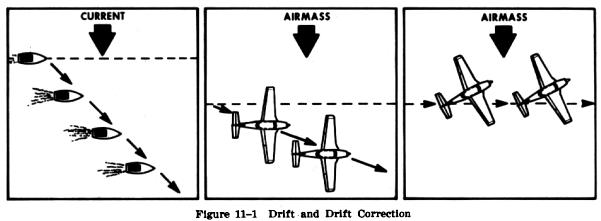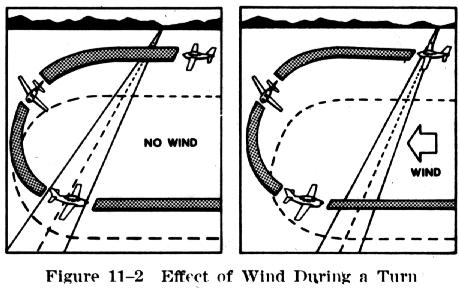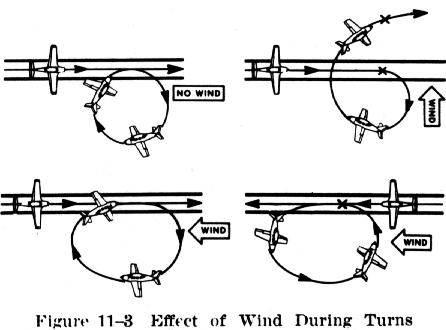
Whenever any object is free from the ground, it is affected by the medium with which it is surrounded. This means that a free object will move in whatever direction and speed that the medium moves.
Such an example is a power boat crossing a river (Fig. 11-1). If the river were still, the boat could head directly to a point on the opposite shore and travel on a straight course to that point without drifting. However, if the river were flowing swiftly, the water current would have to be considered. That is, as the boat progresses forward through its own power, it must also move upstream at the same rate that the river is moving it downstream. This is accomplished by angling the boat upstream sufficiently to counteract the downstream flow. If this is done, the boat will follow the desired track across the river from the departure point directly to the intended destination point. Should the boat not be headed sufficiently upstream, it would drift with the current and run aground at some point downstream on the opposite bank.

As soon as an airplane becomes airborne, it is free of ground friction. Its path is then affected by the air mass in which it is flying. Therefore, the airplane (like the boat) will not always track along the ground in the exact direction that it is headed. When flying with the longitudinal axis of the airplane aligned with a road, it may be noted that the airplane gets closer to or farther from the road without any turn having been made. This would indicate that the air mass is moving sideward in relation to the airplane. Since the airplane is flying within this moving body of air (wind), it moves or drifts with the air in the same direction and speed, just like the boat moved with the river current (Fig. 11-1).
When flying straight and level and following a selected ground track, the preferred method of correcting for wind drift is to head (crab) the airplane sufficiently into the wind to cause the airplane to move forward into the wind at the same rate that the wind is moving it sideways. Depending on the wind velocity, this may require a large crab angle or one of only a few degrees. When the drift has been neutralized, the airplane will follow the desired ground track (Fig. 11-1).
To understand the need for drift correction during flight,
consider a flight with a wind velocity of 30 knots from the left and 90
degrees to the direction the airplane is headed. After one hour, the body
of air in which the airplane is flying will have moved 30 nautical miles
to the right. Since the airplane is moving with this body of air, it too
will have drifted 30 nautical miles to the right. In relation to the air,
the airplane moved forward, but in relation to the ground it moved forward
as well as 30 nautical miles to the right.
| There are times when the pilot needs to correct for drift while in a turn (Fig. 11-2). Throughout the turn the wind will be acting on the airplane from constantly changing angles. The time it takes for the airplane to progress through any part of a turn is governed by the relative wind angle and speed. This is due to the constantly changing groundspeed. When the airplane is headed into the wind the groundspeed is decreased; when headed downwind the groundspeed is increased. Through the crosswind portion of a turn the airplane must be crabbed sufficiently into the wind to counteract drift. To follow a desired circular ground track the crab angle must be varied in a timely manner because of the varying groundspeed as the turn progresses. Thus, the faster the groundspeed the faster the crab must be established; the slower |  |
The principles and techniques of varying the angle of bank to change the rate of turn and crab angle for controlling wind drift during a turn are the same for all ground track maneuvers involving changes in direction of flight.
When there is no wind, it should be simple to fly along a ground track with an arc of exactly 180 degrees and a constant radius because the flightpath and ground track would be identical. This can be demonstrated by approaching a road at a 90 degree angle and, when directly over the road, rolling into a medium banked turn, then maintaining the same angle of bank throughout the 180 degrees of turn (Fig. 11-2).
To complete the turn, the rollout should be started at a point where the wings will become level as the airplane again reaches the road at a 90 degree angle and will be directly over the road just as the turn is completed. This would be possible only if there were absolutely no wind and if the angle of bank and the rate of turn remained constant throughout the entire maneuver.
If the turn were made with a constant angle of bank and a wind blowing directly across the road, it would result in a constant radius turn through the air. However, the wind effects would cause the ground track to be distorted from a constant radius turn or semicircular path. The greater the wind velocity, the greater would be the difference between the desired ground track and the flightpath. To counteract this drift, the flightpath can be controlled by the pilot in such a manner as to neutralize the effect of the wind, and cause the ground track to be a constant radius semicircle.

The effects of wind during turns (Fig. 11-3) can be demonstrated after selecting a road, railroad, or other ground reference which forms a straight line parallel to the wind, by flying into the wind directly over and along the line and then making a turn with a constant medium angle of bank for 360 degrees of turn. The airplane will return to a point directly over the line but slightly downwind from the starting point, the amount depending on the wind velocity and the time required to complete the turn. The path over the ground will be an elongated circle, although in reference to the air it is a perfect circle. Straight flight during the upwind segment after completion of the turn is necessary to bring the airplane back to the starting position.
A similar 360 degree turn may be started at a specific point over the reference line, with the airplane headed directly downwind. In this demonstration the effect of wind during the constant banked turn will drift the airplane to a point where the line is reintercepted, but the 360 degree turn will be completed at a point downwind from the starting point.
Still another reference line which lies directly crosswind may be selected and the same procedure repeated, showing that if wind drift is not corrected the airplane will, at the completion of the 360 degree turn, be headed in the original direction but will have drifted away from the line a distance dependent on the amount of wind.
From these demonstrations, it can be seen where and why it is necessary to increase or decrease the angle of bank and the rate of turn to achieve a desired track over the ground. The principles and techniques involved can be practiced and evaluated by the performance of the ground track maneuvers discussed in this chapter.